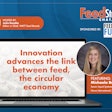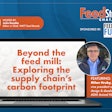
Single-cell proteins are a promising alternative, but aren’t carbon negative or even carbon neutral quite yet
With global governments and consumers increasingly looking for ways to reduce carbon emissions, a carbon neutral, or even carbon negative, animal feed could represent something of a holy grail. But will this particular holy grail ever prove to be more than a myth? Experts say that, in the future, we might find the real deal.
Many plants are naturally carbon negative — that is, they absorb more carbon than they emit. Just think of efforts to plant more trees to save the Amazon rainforest, which serves as one of the world’s largest carbon sinks. Because plants make up the bulk of feeds used in animal production, it seems that feed, too, should be able to achieve a carbon negative status, or at least carbon neutrality. And with advances in technology — and in our ability to cultivate single-cell organisms in particular — a growing number of startups claim to have the capacity to suck carbon straight out of the air and turn it into protein.
But the carbon emissions from feed stem from the way it’s produced, according to Henrik Wenzel, a professor at the University of Southern Denmark and head of the university’s Life Cycle Engineering group, which studies carbon emissions. Single-cell proteins are no exception, he says. It may be technically possible to suck carbon out of the atmosphere and turn it into animal feed, but that doesn’t mean the end result is carbon negative or even carbon neutral — yet.
“Is it practical? The jury is still out on that one in my opinion,” says Larry Feinberg, CEO and co-founder of single cell protein company KnipBio. “But is it possible? Definitely.”
How microbes eat carbon
Talk of turning carbon into protein and animal feed may sound technologically sophisticated, but in reality it’s not as novel as one might expect. Essentially all living things consume carbon in some form as food. Sugar, for example, is comprised of carbon.
The aim of startups that say they turn carbon into animal feed is to cut out the middle man and, in doing so, reduce the environmental impact associated with producing animal feed. But they have a lot of potential options to choose from, Feinberg says. Feeding microbes a carbon-containing gas like methane is an option, but it can be technically tricky. Any number of solids are on the table, but microbes tend to prefer the same kind of solid foods as more complex organisms. Feeding them something that is typically indigestible, like woody cellulose, is possible but often requires an intermediate step to make the carbon more accessible.
Liquids, Feinberg believes, are probably the sweet spot — particularly methanol. But, once again, there are a lot of different ways to make methanol. Sure, you could capture biogas from a landfill and convert it to methanol, which would in turn prevent the methane from the landfill from polluting the atmosphere. Or you could just turn natural gas into methanol — which is easier, cheaper and far more likely to make environmentalists who oppose the extraction of fossil fuels angry.
The reality, Feinberg says, is that most of the single-cell proteins on the market today, including those made by KnipBio, are made using natural gas as a feedstock. Claims that any product sucks carbon out of the air instead of the ground should be taken with a very large grain of salt, says Alan Shaw, CEO of single-cell protein manufacturer Calysta.
“The cost of concentrating [enough CO2 from the air] to enable you to run an industrial process is totally prohibitive and will never see the light of day on an industrial scale, and I can speak as someone who has spent the last 25 years scaling up fermentation processes,” Shaw says. “That technology was developed by NASA, and that’s quite honestly where it belongs; it’s science fiction.”
Feedstock and energy use
Although a reliance on fossil fuels means that few, if any, single-cell proteins are carbon neutral, Shaw believes there is a path forward to carbon neutrality for Calysta and for other companies in the space.
Calysta uses stranded natural gas — that is, natural gas supplies that have limited or no access to transportation chains — as its feedstock of choice. The fact that it provides an outlet for natural gas that otherwise would struggle to reach international markets helps to keep prices low. The fermentation process creates carbon dioxide (CO2) as a byproduct, and this carbon is exhausted into the atmosphere.
But it won’t be that way for too much longer, Shaw says. Although he says he can’t share too many details just yet, the company’s first plant to be equipped with carbon capture technology is on track to be built in the U.S. The carbon capture system will collect CO2 emitted by the fermentation process and store it underground. By driving the carbon capture system and other equipment at the plant with renewable energy, the protein from that particular location should achieve carbon neutrality, Shaw says. That is, the plant will consume as much carbon as it produces, negating its contributions to climate change.
The Calysta plant raises an important point. Beyond the feedstock itself, the source of energy used to power a single-cell protein operation is another significant consideration that will determine whether the product can be considered carbon neutral, according to Henrik Busch-Larsen, former CEO of Unibio and now founder and CEO of Algiecel, which aims to produce algae-based feed ingredients while marketing the technology as a carbon capture service concept. Single-cell proteins may be able to make use of carbon as a food source, but they need some form of energy in order to drive the conversion of carbon into usable biomass. In a field of crops, Busch-Larsen says, the sun would provide that energy. But in an industrial setting, such as a photobioreactor, it must come from some other source.
If that power comes from a solar energy farm or from an electrical grid that is 100% green, then that single-cell producer may be close to achieving carbon neutrality or could even go negative. But if you’re drawing power from a coal plant, Busch-Larsen says, that’s a different story, because the energy you use is generating substantial carbon emissions.
A broader picture
Carbon capture and access to renewable energy pave the way toward carbon neutrality for single-cell protein producers, but creating a truly carbon negative feed ingredient — one that not only avoids carbon emissions but actually absorbs them — is another matter. Still, it could one day be possible.
Developing the technical capacity to recycle carbon emissions from fermentation processes isn’t terribly difficult, Shaw says. It could be done today, with the microbes and equipment used in Calysta’s planned and existing plants.
However, to use the plant’s CO2 emissions as a food source for the microbes would require mixing the emissions with hydrogen, Shaw says. And hydrogen at the moment costs more than operating a carbon capture and sequestration system.
“If hydrogen ever becomes cost competitive, we could mix it with CO2 and put it back into the reactor — that’s brilliant,” Shaw says. “We don’t need to change our technology to use CO2 and hydrogen. We’ve already got a plant that is totally scalable. … It’s just that at the moment it’s cheaper to buy [natural gas and electricity] from the grid and put the carbon back into the ground.”
So for now, carbon-sucking microbes will remain a dream of the future. But there are still environmental benefits associated with single-cell proteins that could help the world combat climate change.
The chief environmental benefit associated with alternative protein production isn’t only about reducing carbon emissions, Busch-Larsen says, it’s arable land use. A single plant located in an industrial park or in remote areas near inaccessible natural gas can produce tons of protein that would otherwise require hectares upon hectares of land to grow. With growing global demand for protein, that means single-cell proteins can help prevent further deforestation from critical carbon sinks like the Amazon rainforest. And maintaining or even restoring global forests, he says, means less overall carbon in the atmosphere and less climate change in the long term.
“I really believe that biosolutions are a game changer, and I’m also envisioning a future where you can grow forest instead of reducing forest because you can produce a lot of these alternative protein products industrially,” Busch-Larsen says.
Feed Mill of the Future digital supplement
WATT’s feed brands Feed Strategy and Feed & Grain magazines join forces to launch the monthly Feed Mill of the Future digital supplement. Each edition aims to provide animal feed industry stakeholders with forward-looking content, market insights and a spotlight on the leading-edge technologies shaping the global feed industry of tomorrow.
Subscribe today! https://bit.ly/3dWzow7

















